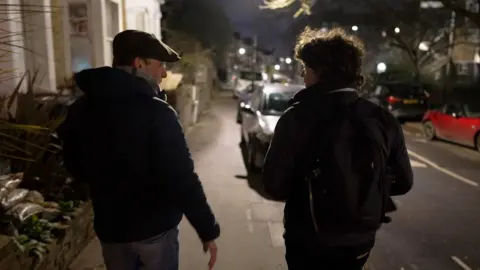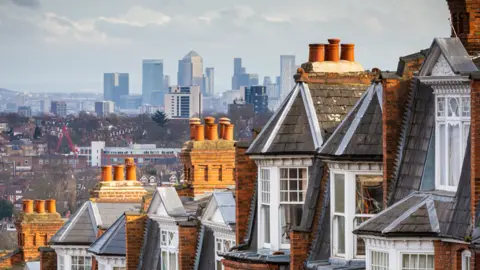Wood burners: On smoke patrol in London

 BBC
BBCIt is a cold, clear night and we are walking around north London.
We are on smoke patrol with researchers from Imperial College.
John Casey is a senior air quality analyst.
He has a backpack on that is measuring air pollution - a little gadget inside shows a number that jumps around.
When we start off, it is showing 11 µg/m3.
It doesn't take too long until we smell smoke.
We look inside the backpack and it has jumped to 45µg/m3.
This is a measurement of particulate matter per cubic metre, or PM2.5s, in the atmosphere.
They are tiny harmful particles.
 Getty Images
Getty Images"Our readings have gone from about 11 or 12 up to 40 or 45", Mr Casey observes.
"It means there's more PM2.5s, so someone is burning solid fuel - either wood or smokeless coal."
"When we analyse this data we'll get an idea if there's a lot of wood in that".
The equipment can differentiate between types of smoke.
What's the problem with PM2.5?
Exposure to PM2.5 causes illnesses like asthma, COPD (chronic obstructive pulmonary disease), coronary heart disease, stroke, and lung cancer, according to a report by the Royal College of Physicians.
The World Health Organisation-recommended average limit for a year is 5 µg/m3 and says the 24-hour average exposures should not exceed 15 µg/m3.
Imperial College is doing these smoke walks to see how widespread the impact of wood burners is on our air.
The issue of wood burners is heading up the political agenda.
While work is being done to reduce emissions from traffic, the pollution from wood burners seems to be increasing.
They have become more fashionable and also essential for some in the cost-of-living crisis.
Data from Imperial College shows that 17% of PM2.5s in London now comes from wood-burning.
 Getty Images
Getty ImagesThe legislation controlling fires in London comes in part from the Clean Air Act in 1956, which followed the Great Smog in 1952 that killed thousands.
It means London is a smokeless zone as it became an offence to emit dark smoke from a chimney and coal-burning was banned in urban areas.
Only smokeless fuel can be burnt on an open fire.
More recently in London, only government-approved wood burners, called eco-stoves, are allowed and you must only burn dry kiln-dried logs. Wet log sales are now banned.
If you break the rules you could face a fine of £1,000.
But many are confused about the law and enforcement is almost non-existent.
How 'eco' can stoves really be?
The problem with the legislation, according to health campaigners is, whatever you burn, it still emits pollution and PM2.5s.
Sarah Woolnough, from Asthma + Lung UK, says: "A lot of these things are sold as eco-stoves and that they're somehow good for the environment and good for health.
"The reality is they're not. Various reports show just how much pollution they're emitting.
"People need to be aware of the risks and understand what these stoves can be doing to health."
Campaigner Jemima Hartson from Mums for Lungs agrees. She wants this kind of heating phased out entirely, if people have alternative ways of heating their home.
"Domestic wood burning, whether in a stove or an open fire, is one of the main sources of PM2.5, the most harmful of all pollutants, leading to respiratory illnesses, cardiac issues and many other irreversible health problems.
"Nobody in one of the richest countries in the world should have to choose between heating, eating and polluting the air that their children and neighbours breathe," she said.
A report from the European Environment Bureau showed that even the cleaner authorised eco-stoves produced 750 times more PM2.5 per unit of energy than a modern lorry.
Is a complete ban the answer?
At Amazing Grates the room is warm and there is a log burner going in the corner.
The business has been here in East Finchley for 40 years and they have seen an increase in people putting in approved stoves.
They think new technology will make stoves more and more clean and the real problem is people illegally burning wood on open fires.
Charlotte Tew is the owner: "Yes I do think we should have wood burners in London. The reality is that people who are using them, you're not using your central heating, you're not using fossil fuels in the same way.
"You're using one source of heat to generally heat the room you're in. People generally open up their doors and it's going round the house.
"And the emissions aren't as big compared to cars or smoking or all the other things in our lives that cause us problems.
"The emissions are tiny compared to an open fire and that's my concern that's what people are doing, they're having open fires."
Recently the London mayor set an air quality limit that means large home and office developments can no longer use wood or solid fuels.
The new Air Quality Neutral (AQN) guidance states that all new developments in London must not contribute to net air pollution.
Many think that eventually, legislation will go further and urban environments are no place for burning wood.
Prof Frank Kelly, from Imperial College, believes all types of burning will have to be phased out: "I think it probably is inevitable that they are banned.
"In the future we will have to stop burning things.
"Any form of combustion, be it gas cooking, wood-burning, or a diesel vehicle, they all produce pollution and for climate change and the benefit of our citizens' health, we will have to move to cleaner alternatives. "

Follow BBC London on Facebook, Twitter and Instagram. Send your story ideas to [email protected]
